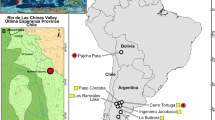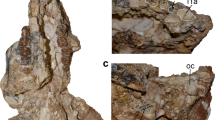Abstract
Dryolestoids are an extinct mammalian group belonging to the lineage leading to modern marsupials and placentals1,2. Dryolestoids are known by teeth and jaws from the Jurassic period of North America and Europe2,3, but they thrived in South America up to the end of the Mesozoic era and survived to the beginnings of the Cenozoic2,4,5,6,7. Isolated teeth and jaws from the latest Cretaceous of South America provide mounting evidence that, at least in western Gondwana, dryolestoids developed into strongly endemic groups by the Late Cretaceous4,5,6,7,8,9. However, the lack of pre-Late Cretaceous dryolestoid remains made study of their origin and early diversification intractable. Here we describe the first mammalian remains from the early Late Cretaceous of South America, including two partial skulls and jaws of a derived dryolestoid showing dental and cranial features unknown among any other group of Mesozoic mammals, such as single-rooted molars preceded by double-rooted premolars, combined with a very long muzzle, exceedingly long canines and evidence of highly specialized masticatory musculature. On one hand, the new mammal shares derived features of dryolestoids1,2,3 with forms from the Jurassic of Laurasia, whereas on the other hand, it is very specialized and highlights the endemic, diverse dryolestoid fauna from the Cretaceous of South America. Our specimens include only the second mammalian skull known for the Cretaceous of Gondwana, bridging a previous 60-million-year gap in the fossil record, and document the whole cranial morphology of a dryolestoid, revealing an unsuspected morphological and ecological diversity for non-tribosphenic mammals.
This is a preview of subscription content, access via your institution
Access options
Subscribe to this journal
Receive 51 print issues and online access
$199.00 per year
only $3.90 per issue
Buy this article
- Purchase on Springer Link
- Instant access to full article PDF
Prices may be subject to local taxes which are calculated during checkout





Similar content being viewed by others
References
Prothero, D. R. New Jurassic mammals from Como Bluff, Wyoming, and the interrelationships of non-tribosphenic Theria. Bull. Am. Mus. Nat. Hist. 167, 281–317 (1981)
Kielan-Jaworowska, Z., Cifelli, R. L. & Luo, Z. X. Mammals from the Age of Dinosaurs. Origins, Evolution, and Structure (Columbia Univ. Press, 2004)
Martin, T. Dryolestidae (Dryolestoidea, Mammalia) aus dem Oberen Jura von Portugal. Abh. Senckenb. Naturforsch. Ges. 550, 1–119 (1999)
Bonaparte, J. F. Sobre Mesungulatum housayi y nuevos mamíferos cretácicos de Patagonia, Argentina. Actas Congr. Argent. Paleontol. Estratigr. 2, 63–95 (1986)
Bonaparte, J. F. New Late Cretaceous mammals from the Los Alamitos Formation, southern Patagonia. Natl Geogr. Res. 6, 63–93 (1990)
Bonaparte, J. F. Approach to the significance of the Late Cretaceous mammals of South America. Berliner Geowiss. 13, 30–44 (1994)
Gelfo, J. N. & Pascual, R. Peligrotherium tropicalis (Mammalia, Dryolestida) from the early Paleocene of Patagonia, a survival from a Mesozoic Gondwanan radiation. Geodiversitas 23, 69–379 (2001)
Rougier, G. W., Forasiepi, A. M., Hill, R. V. & Novacek, M. J. New mammalian remains from the Late Cretaceous La Colonia Formation, Patagonia, Argentina. Acta Palaeontol. Pol. 54, 195–212 (2009)
Chornogubsky, L. New remains of the dryolestoid mammal Leonardus cuspidatus from the Los Alamitos Formation (Late Cretaceous, Argentina). Paläont. Z. 85, 1–8 (2011)
Leanza, H. A., Apesteguía, S., Novas, F. E. & de la Fuente, M. S. Cretaceous terrestrial beds from the Neuquén Basin (Argentina) and their tetrapod assemblages. Cretac. Res. 25, 61–87 (2004)
Apesteguía, S. & Novas, F. E. Large Cretaceous sphenodontian from Patagonia provides insight into lepidosaur evolution in Gondwana. Nature 425, 609–612 (2003)
Apesteguía, S. & Zaher, H. A. Cretaceous terrestrial snake with robust hindlimbs and a sacrum. Nature 440, 1037–1040 (2006)
Gallina, P. A. & Apesteguía, S. Cathartesaura anaerobica gen. et sp. nov., a new rebbachisaurid (Dinosauria, Sauroppoda) from the Huincul Formation (Upper Cretaceous), Río Negro, Argentina. Rev. Mus. Argent. Cienc. Nat. 7, 153–166 (2005)
Makovicky, P., Apesteguía, S. & Agnolín, F. L. The earliest dromaeosaurid theropod from South America. Nature 437, 1007–1011 (2005)
Páez Arango, N. Dental and Craniomandibular Anatomy of Peligrotherium tropicalis: the Evolutionary Radiation of South American Dryolestoid Mammals. Thesis, Univ. Louisville. (2008)
Krebs, B. Drescheratherium acutum gen. et sp. nov., ein neuer Eupantotherier (Mammalia) aus dem Oberen Jura von Portugal. Berliner Geowiss. 28, 91–111 (1998)
Bonaparte, J. F. & Migale, L. A. Protomamíferos y mamíferos Mesozoicos de América del Sur (Museo de Ciencias Naturales Carlos Ameghino, 2010)
Bonaparte, J. F. Una nueva especie de Triconodonta (Mammalia) de la Formación Los Alamitos, Provincia de Río Negro y comentarios sobre su fauna de mamíferos. Ameghiniana 29, 99–110 (1992)
Rougier, G. W. & Wible, J. R. In Amniote Paleobiology: Phylogenetic and Functional Perspectives on the Evolution of Mammals, Birds and Reptiles (eds Carrano, M. T., Gaudin, T. J., Blob, R. & Wible, J. R. ) 269–311 (Univ. Chicago Press, 2006)
Turnbull, W. D. Mammalian masticatory apparatus. Fieldiana Geol. 18, 153–356 (1970)
Meng, J., Wang, Y. & Li, C. Transitional mammalian middle ear from a new Cretaceous Jehol eutriconodont. Nature 472, 181–185 (2011)
Wible, J. R., Rougier, G. W., Novacek, M. J. & Asher, R. J. The eutherian mammal Maelestes gobiensis from the Late Cretaceous of Mongolia and the phylogeny of Cretaceous eutherians. Bull. Am. Mus. Nat. Hist. 327, 1–123 (2009)
Rougier, G. W. et al. In Dinosaurios y Paleontología desde América Latina (eds Calvo, J., Porfiri, J., González Riga, B. & Dos Santos, D. ) 195–214 (Editorial de la Universidad Nacional de Cuyo, 2011)
Luo, Z. X., Kielan-Jaworowska, Z. & Cifelli, R. L. In quest for a phylogeny of Mesozoic mammals. Acta Palaeontol. Pol. 47, 1–78 (2002)
Rowe, T. B., Rich, T. H., Vickers-Rich, P., Springer, M. & Woodburne, M. O. The oldest platypus and its bearing on divergence timing of the platypus and echidna clades. Proc. Natl Acad. Sci. USA 105, 1238–1242 (2008)
Sigogneau-Russell, D. Further data and reflexions on the tribosphenid mammals (Tribotheria) from the Early Cretaceous of Morocco. Bull. Mus. Natl Hist. Nat. Paris 16, 291–312 (1995)
Wilson, G. P., Das Sarma, D. C. & Anantharaman, S. Late Cretaceous sudamericid gondwanatherian mammals from India with paleobiogeographic considerations of Gondwanan mammals. J. Vertebr. Paleontol. 27, 521–531 (2007)
Gurovich, Y. & Beck, R. The phylogenetic position of the enigmatic mammalian clade Gondwanatheria. J. Mamm. Evol. 16, 25–49 (2009)
Sigogneau-Russell, D. & Ensom, P. C. Thereuodon (Theria, Symmetrodonta) from the Lower Cretaceous of North Africa and Europe, and a brief review of symmetrodonts. Cretac. Res. 19, 445–470 (1998)
Fox, R. C. Upper molar structure in the Late Cretaceous symmetrodont Symmetrodontoides Fox, and a classification of the Symmetrodonta (Mammalia). J. Paleontol. 59, 21–26 (1985)
Acknowledgements
We thank M. Salinas, P. A. Gallina and P. J. Makovicky for finding the best specimens; the Avelás and Pincheira families for logistical support; C. Muñoz and R. Barbieri from the MPCA for access to collections under their care; J. A. González and A. Davidson for illustration and technical assistance. Field work permits and loans were facilitated by M. Solorza. C. Corbitt and J. R. Wible read an earlier version of the manuscript. Field work and research was supported by the Antorchas Foundation, American Museum of Natural History and NSF grants DEB 0946430, DEB 1068089 and ATOL 0629959 (to G.W.R.), The Jurassic Foundation (to S.A.) and NASA and Field Museum Womens’ Board (to P. J. Makovicky). This is L.C.G.’s R-46 contribution to the IDEAN.
Author information
Authors and Affiliations
Contributions
G.W.R. wrote the manuscript with contributions from all authors, edited the figures, scored the matrix and performed the phylogenetic analysis; S.A. edited the manuscript and figures; L.C.G. edited the manuscript, figures, matrix and performed the phylogenetic analysis.
Corresponding author
Ethics declarations
Competing interests
The authors declare no competing financial interests.
Supplementary information
Supplementary Information
The file contains Supplementary Text (Parts 1 and 2), Supplementary Figures 1-4 with legends and additional references. (PDF 1362 kb)
Rights and permissions
About this article
Cite this article
Rougier, G., Apesteguía, S. & Gaetano, L. Highly specialized mammalian skulls from the Late Cretaceous of South America. Nature 479, 98–102 (2011). https://doi.org/10.1038/nature10591
Received:
Accepted:
Published:
Issue Date:
DOI: https://doi.org/10.1038/nature10591
This article is cited by
-
Early Cretaceous lepidosaur (sphenodontian?) burrows
Scientific Reports (2023)
-
Mandibular and dental characteristics of the Late Jurassic mammal Henkelotherium guimarotae (Paurodontidae, Dryolestida)
PalZ (2023)
-
A new Cretaceous thyreophoran from Patagonia supports a South American lineage of armoured dinosaurs
Scientific Reports (2022)
-
An African Radiation of ‘Dryolestoidea’ (Donodontidae, Cladotheria) and its Significance for Mammalian Evolution
Journal of Mammalian Evolution (2022)
-
New cladotherian mammal from southern Chile and the evolution of mesungulatid meridiolestidans at the dusk of the Mesozoic era
Scientific Reports (2021)
Comments
By submitting a comment you agree to abide by our Terms and Community Guidelines. If you find something abusive or that does not comply with our terms or guidelines please flag it as inappropriate.



